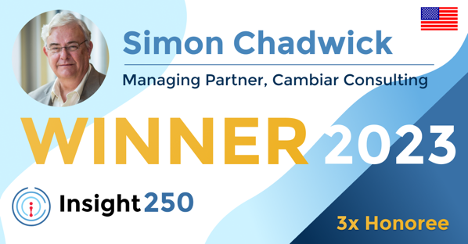Inspecting the Insights Industry
Simon Chadwick explains how market research and insights are evolving across a series of dimensions and how the importance of insights continues to grow.

The Insight250 spotlights and celebrates 250 of the world’s premier leaders and innovators in market research, consumer insights, and data-driven marketing. The inaugural list was revealed in April 2021, and the 2022 winners were announced in Toronto last September at ESOMAR’s Annual Congress. The awards have created renewed excitement across the industry whilst strengthening the connectivity of the market research community. The 2023 Winners were announced this past July and can be seen at Insight250.com.
With so many exceptional professionals named to the Insight250, it seems fitting to tap into their expertise and unique perspectives across various topics. This weekly series does just that: inquiring about the expert perspectives of many of these individuals in a series of short topical features.
This edition features Simon Chadwick, Managing Partner for Cambiar Consulting and Editor-In-Chief of Research World. Simon is also a three-time Insight250 honoree. I sat down with Simon to discuss a broad range of topics in the insight industry, from investment to talent trends. Simon explains how market research and insights are evolving across a series of dimensions and how the importance of insights continues to elevate.
Crispin: Having held CEO and Chair roles at agencies such as Research International and NOP and associations such as CASRO and the Insights Association, Simon, you’ve been a leader and innovator in our profession for decades. For the last 20 years, you’ve been the Managing Partner of Cambiar LLC, which specialises in helping insight companies and departments maximise their strategic positioning and value. So firstly, how big is our market, and how do you define it when segments and companies change so dramatically?
This question has been at the centre of much debate for the last few years – and will probably continue to be so for many more. Until recently, the market was relatively tightly defined as being full-service research agencies, but that misses out on the huge marketing data analytics market, social listening, communities, and a burgeoning research technology sector that runs the gamut from DIY platforms to ‘Do It With Me’ ones. The major associations have settled for now on there being eight segments to the industry, of which the originally defined full-service agencies are one (euphemistically referred to as Establish Research).
“With this in mind, some extraordinary teams and individuals worldwide labour to provide as accurate a count of the market’s size as is humanly possible – a Herculean and almost impossible task. Debate still rages around what counts and what doesn’t. For example, do the consulting companies really sell as much research and analytics as is reported?
“Many consultants working in “big consulting” don’t think they do or indeed that there is a reliable way of accounting for it. Similarly, there are those who wonder what firms such as Adobe and HubSpot are doing in the analysis, but the fact is that these firms sell a huge amount of data analytics aimed at understanding market dynamics.
“All that being said, ESOMAR estimated the 2021 global market to be just shy of $119 billion – bigger than the global coffee, cloud services, or digital music markets. Initial incoming intelligence suggests growth of 13% in 2022 to $134 billion."
Simon Chadwick
What areas do you see growing most quickly, and will that continue?
The fastest growth areas include digital data analytics, social media listening, and self-service platforms of all shapes and sizes. With the advent of Generative AI, I expect that the primary focus for organisations and investors alike will be unstructured data. Companies have more than five times the amount of unstructured data they have of the structured variety, and that pile is growing three times faster. Being able to mine this treasure trove at a huge scale and rapid speed for previously hidden insight assets will be akin to the next gold rush.”
Simon Chadwick
There has been significant market consolidation in recent years - will M&A activity increase, decline, or change in 2024?
The nature of M&A in our industry has changed dramatically over the last five years. Not only have we seen tens of billions of dollars enter the industry via venture capital, but the biggest owners within the industry now are private equity companies. PE is building the next version of the insights ecosystem, and I don’t see that diminishing any time soon. Obviously, current PE owners will hope to offload what they create in the next few years, either via sale to major strategic corporations or via IPO, but let’s not forget that venture capital is going to have to unload a lot of assets as well and their primary buyer market is still likely to be private equity.”
Simon Chadwick
You’ve talked about our market regarding financials, but how big is it regarding people?
Nobody, to my knowledge, can lay claim to really knowing the answer to this question. However, my back-of-the-envelope calculations based on average revenue per head across the globe would suggest the insights supply industry employs around 600,000 people. Factoring in consumer insights and data analytics functions within companies equating in size to the Fortune 1000, we can probably add another 25,000 to 30,000 to this total.”
Simon Chadwick
You’ve been involved in considerable M&A activity – what, in your opinion, makes a great agency?
A great agency knows exactly what it is good at, what differentiates it, and what client issues it is trying to help solve. It will inspire leadership to work toward a clear and well-articulated strategy, and management will communicate that strategy relentlessly. But, because culture eats strategy for lunch, it is imperative that anyone thinking of buying that agency has a very clear understanding of the culture. There are various telltale signs to look for:
Do employees, from management on down, show passion for who they are and what they do?
Do their clients see that same passion?
Is employee attrition below average, and
Does the company spend less than average on recruitment costs? If the answers to these questions are all yes and the company is growing well, then there’s likely a basis for further growth in the future. If, however, any of these factors are out of sync, at some point, the company will run into a wall.”
Simon Chadwick
How do you train people to ensure those skills become embedded, so to speak, in their DNA?
No training can be done in isolation, either in time as a ‘one-off’ or solely as theory. Training abides by Mehrabian’s Model of Communication – 7% of the information we want to impart will be received through words, 38% through observing, and 55% through ‘the dance’ – actually doing and experiencing what is being imparted. I was trained at the University of UK market research, Research International – the course lasted two years, and we were constantly doing, not just listening.”
Simon Chadwick
Why does so much training fail to deliver the sought-after improvements?
In part for the above reasons but also because many companies try to use training to change culture. In order to take hold, culture has to be experienced, witnessed, and felt. It cannot be ‘trained into’ people, particularly if they do not understand or even agree with what is being told to them. Employees are not stupid – if they sniff a hint of dissonance between what they are being taught and what they see and experience, the training will fail.”
Simon Chadwick
How can organisations best recruit, train, and retain the right skills to enhance innovation and leadership?
The two biggest sins in recruitment are (i) To recruit to a job description and a résumé and (ii) To recruit in one’s own likeness. Sadly, with increasingly digitised recruitment platforms, candidates are increasingly being assessed on whether their CV ‘ticks the boxes,’ not whether they have the passion, creativity, and capabilities to learn, innovate, inspire, and lead. Worse, if the hiring manager judges the candidate on whether they ‘fit’ with them and the rest of the team in an interview, then the innovation and creativity born out of diversity is snuffed from the get-go. So, recruit based on the person and what they bring that is new, invigorating, different, and surprising. From there, learning (as opposed to training) and retention will be self-sustaining."
Simon Chadwick
Hot Topics
Simon, you’ve been Editor-in-Chief of Research World for over 15 years. How have you kept the publication relevant during that time?
First and foremost, I have been hugely fortunate throughout to have had a team that is outstanding and who view Research World with the passion of a loving parent. We have stuck to certain core principles – we bring an international community together, we showcase the rich diversity of talent, innovation, and thinking from around the world, and we are not afraid to be controversial if being so can be a force for good.
“At the same time, we have never feared to innovate with the product itself, both when it was paper and more recently as a digital magazine. We’ve innovated in the types of content, how and from whom we source it, the degree to which we have encouraged hot topic debates…you name it, we’ve tried it.
“If there’s one thing about this team, it is relentless. And it shows in the results. When I was invited on board 15 years ago, we had a reach of about 4,000 people. Today, it’s 10 times more, not to mention that we constantly spark great debates and greater reach on LinkedIn and Twitter (RIP).”
Simon Chadwick
How do you see Research World continuing to innovate and evolve?
Over the coming months, expect to see Research World evolve into much more of a multimedia digital platform, an “organic content magnet” that will act as a hub of information, debate, resources, and opinion for the wider insights audience. It will be unique and innovative but, as ever, true to its timeless core principles.”
Simon Chadwick
Top tip:
Simon, what would your top tip be for readers?
Remember: however our industry is defined, however tech-enabled it is or becomes, at heart, it is still about understanding and meeting human needs, however irrational they may be. That calls for curiosity, empathy and other human-centric skills that no amount of AI or tech can provide. This is and will always remain a fundamentally human industry.”
Simon Chadwick
Thanks, Simon. Fascinating insights.
 Simon Chadwick has served as an executive, consultant, and writer for over 40 years. Currently, he serves as Managing Partner for Cambiar, a consulting firm that advises the market research and marketing services industries, focusing on M&A, strategic consulting, and operational insight. Simon also serves as Editor-in-Chief of ESOMAR’s Research World publication and is the former Chairman of the Insights Association.
Simon Chadwick has served as an executive, consultant, and writer for over 40 years. Currently, he serves as Managing Partner for Cambiar, a consulting firm that advises the market research and marketing services industries, focusing on M&A, strategic consulting, and operational insight. Simon also serves as Editor-in-Chief of ESOMAR’s Research World publication and is the former Chairman of the Insights Association.
Crispin Beale
Chairman at QuMind, CEO at Insight250, Senior Strategic Advisor at mTab, CEO at IDXCrispin Beale is a marketing, data and customer experience expert. Crispin spent over a decade on the Executive Management Board of Chime Communications as Group CEO of leading brands such as Opinion Leader, Brand Democracy, Facts International and Watermelon. Prior to this Crispin held senior marketing and insight roles at BT, Royal Mail Group and Dixons. Crispin originally qualified as a chartered accountant and moved into management consultancy with Coopers & Lybrand (PwC). Crispin has been a Board Director (and Chairman) of the MRS for nearly 20 years and UK ESOMAR Representative for c15 years. As well as being CEO of Insight250, Crispin is currently Worldwide CEO of Digital Communications Solution Agency, IDX. Crispin is also the Senior Strategic Advisor at mTab and the Chairman of QuMind and spent 4 years as Group President of Behaviorally where he was responsibile for the client & commercial teams globally. Crispin is a passionate advocate for blending human intelligence and technology to deliver innovation and leadership across organisations.


